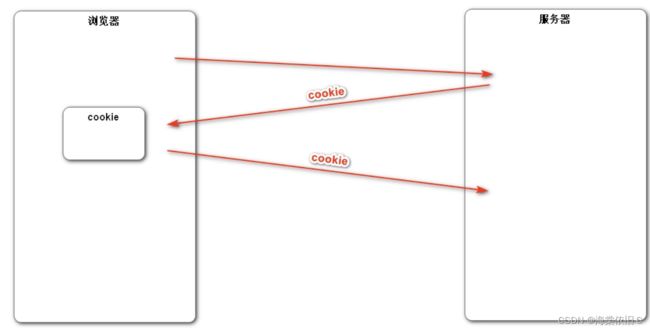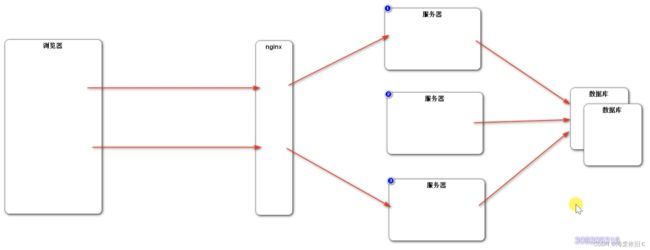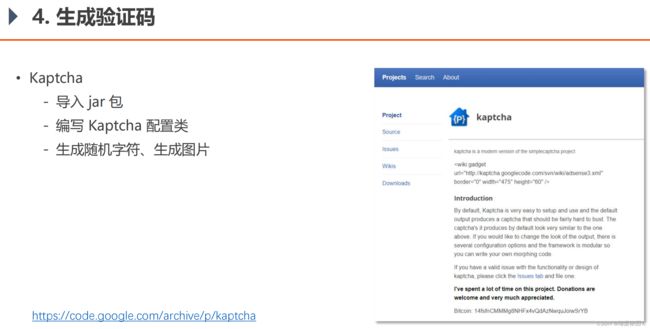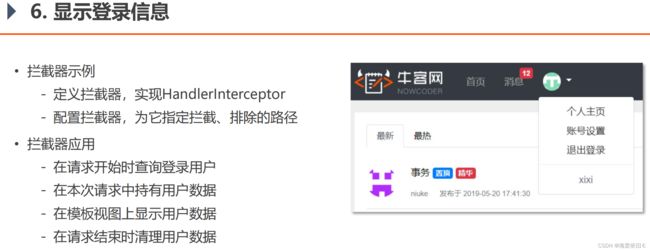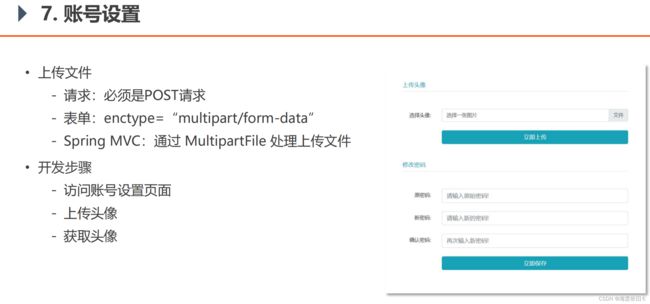学习笔记:基于SpringBoot的牛客网社区项目实现(五)之登陆模块
一、发送邮件
发送邮件主要使用JavaMailSender类,使用send方法,send方法需要MimeMessage类型的参数。
void send(MimeMessage var1)
使用createMimeMessage()方法并用MimeMessage类型接收。再创建MimeMessageHelper()对象,添加一些数据。
MimeMessage message = mailSender.createMimeMessage(); MimeMessageHelper helper = new MimeMessageHelper(message); helper.setFrom(from); helper.setTo(to); helper.setSubject(subject); helper.setText(content, true);
最后发送邮件
mailSender.send(helper.getMimeMessage());
二、Cookie和Session的使用
Cookie
因为是服务器发送给浏览器的,所以加上HttpServletResponse对象,给浏览器返回数据。创建cookie直接new Cookie对象就可以了,然后设置cookie的内容,生效范围,生存时间,最后通过response发送cookie。得到cookie直接使用注解@CookieValue,很方便。
//cookie示例
@RequestMapping(path = "/cookie/set", method = RequestMethod.GET)
@ResponseBody
public String setCookie(HttpServletResponse response) {
//创建cookie
Cookie cookie = new Cookie("code", CommunityUtil.generateUUID());
//设置cookie生效的范围
cookie.setPath("/community/alpha");
//设置cookie生存时间
cookie.setMaxAge(60 * 10);//10min
//发送cookie
response.addCookie(cookie);
return "set cookie";
}
@RequestMapping(path = "/cookie/get", method = RequestMethod.GET)
@ResponseBody
public String getCookie(@CookieValue("code") String code) {
System.out.println(code);
return "get cookie";
}Session
Session是存在服务端的,使用HttpSession对象创建,然后setAttribute信息。
//session示例
@RequestMapping(path = "/session/set", method = RequestMethod.GET)
@ResponseBody
public String setSession(HttpSession session) {
session.setAttribute("id", 1);
session.setAttribute("name", "Test");
return "set session";
}
@RequestMapping(path = "/session/get", method = RequestMethod.GET)
@ResponseBody
public String getSession(HttpSession session) {
System.out.println(session.getAttribute("id"));
System.out.println(session.getAttribute("name"));
return "get session";
}三、生成验证码
package com.nowcoder.community.config;
import com.google.code.kaptcha.Producer;
import com.google.code.kaptcha.impl.DefaultKaptcha;
import com.google.code.kaptcha.util.Config;
import org.springframework.context.annotation.Bean;
import org.springframework.context.annotation.Configuration;
import java.util.Properties;
@Configuration
public class KaptchaConfig {
@Bean
public Producer kaptchaProducer() {
Properties properties = new Properties();
properties.setProperty("kaptcha.image.width", "100");
properties.setProperty("kaptcha.image.height", "40");
properties.setProperty("kaptcha.textproducer.font.size", "32");
properties.setProperty("kaptcha.textproducer.font.color", "0,0,0");
properties.setProperty("kaptcha.textproducer.char.string", "0123456789ABCDEFGHIJKLMNOPQRSTUVWXYAZ");
properties.setProperty("kaptcha.textproducer.char.length", "4");
properties.setProperty("kaptcha.noise.impl", "com.google.code.kaptcha.impl.NoNoise");
DefaultKaptcha kaptcha = new DefaultKaptcha();
Config config = new Config(properties);
kaptcha.setConfig(config);
return kaptcha;
}
}
生成文字的验证码放入session中,方便后续登录输入的验证码是否正确,最后生成图片验证码输出到浏览器中。
@RequestMapping(path = "/kaptcha", method = RequestMethod.GET)
public void getKaptcha(HttpServletResponse response, HttpSession session) {
// 生成验证码
String text = kaptchaProducer.createText();
BufferedImage image = kaptchaProducer.createImage(text);
// 将验证码存入session
session.setAttribute("kaptcha", text);
// 将图片输出给浏览器
response.setContentType("image/png");
try {
OutputStream os = response.getOutputStream();
ImageIO.write(image, "png", os);//image:图片对象,"bmg" :图片格式, filWriterOne 需要写入的地方
} catch (IOException e) {
logger.error("响应验证码失败:" + e.getMessage());
}
}ServletOutputStream getOutputStream()
获得字节流,通过该字节流的write(byte[] bytes)可以向response缓冲区中写入字节,再由Tomcat服务器将字节内容组成Http响应返回给浏览器。
response.getWriter().write("字符串"),这个方法只能写字符串。如果要写字节,比如,传个图片,怎么办呢?就要靠response.getOutputStream()
四、登录功能实现
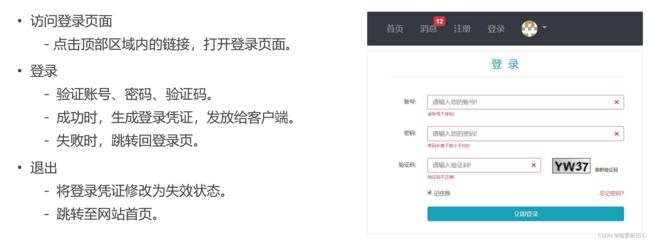
@RequestMapping(path = "/login", method = RequestMethod.POST)
public String login(String username, String password, String code, boolean rememberme,
Model model, HttpSession session, HttpServletResponse response) {
// 检查验证码
String kaptcha = (String) session.getAttribute("kaptcha");
if (StringUtils.isBlank(kaptcha) || StringUtils.isBlank(code) || !kaptcha.equalsIgnoreCase(code)) {
model.addAttribute("codeMsg", "验证码不正确!");
return "/site/login";
}
// 检查账号,密码
int expiredSeconds = rememberme ? REMEMBER_EXPIRED_SECONDS : DEFAULT_EXPIRED_SECONDS;
Map map = userService.login(username, password, expiredSeconds);
if (map.containsKey("ticket")) {
Cookie cookie = new Cookie("ticket", map.get("ticket").toString());
cookie.setPath(contextPath);
cookie.setMaxAge(expiredSeconds);
response.addCookie(cookie);
return "redirect:/index";
} else {
model.addAttribute("usernameMsg", map.get("usernameMsg"));
model.addAttribute("passwordMsg", map.get("passwordMsg"));
return "/site/login";
}
} @RequestMapping(path = "/logout", method = RequestMethod.GET)
public String logout(@CookieValue("ticket") String ticket) {
userService.logout(ticket);
return "redirect:/login";
}五、拦截器的应用
有许多请求同一个方法,统一对这些请求处理,比如访问账号设置一定要在用户登录的情况下才能访问,那么访问用户是否登录这个功能便可以使用拦截器进行实现。
package com.nowcoder.community.controller.interceptor;
import com.nowcoder.community.annotation.LoginRequired;
import com.nowcoder.community.util.HostHolder;
import org.springframework.beans.factory.annotation.Autowired;
import org.springframework.stereotype.Component;
import org.springframework.web.method.HandlerMethod;
import org.springframework.web.servlet.HandlerInterceptor;
import javax.servlet.http.HttpServletRequest;
import javax.servlet.http.HttpServletResponse;
import java.lang.reflect.Method;
@Component
public class LoginRequiredInterceptor implements HandlerInterceptor {
@Autowired
private HostHolder hostHolder;
@Override
public boolean preHandle(HttpServletRequest request, HttpServletResponse response, Object handler) throws Exception {
if (handler instanceof HandlerMethod) {
HandlerMethod handlerMethod = (HandlerMethod) handler;
Method method = handlerMethod.getMethod();
LoginRequired loginRequired = method.getAnnotation(LoginRequired.class);
if (loginRequired != null && hostHolder.getUser() == null) {
response.sendRedirect(request.getContextPath() + "/login");
return false;
}
}
return true;
}
}
六、账号设置
@LoginRequired
@RequestMapping(path = "/upload", method = RequestMethod.POST)
public String uploadHeader(MultipartFile headerImage, Model model) {
if (headerImage == null) {
model.addAttribute("error", "您还没有选择图片!");
return "/site/setting";
}
String fileName = headerImage.getOriginalFilename();
String suffix = fileName.substring(fileName.lastIndexOf("."));
if (StringUtils.isBlank(suffix)) {
model.addAttribute("error", "文件的格式不正确!");
return "/site/setting";
}
// 生成随机文件名
fileName = CommunityUtil.generateUUID() + suffix;
// 确定文件存放的路径
File dest = new File(uploadPath + "/" + fileName);
try {
// 存储文件
headerImage.transferTo(dest);
} catch (IOException e) {
logger.error("上传文件失败: " + e.getMessage());
throw new RuntimeException("上传文件失败,服务器发生异常!", e);
}
// 更新当前用户的头像的路径(web访问路径)
// http://localhost:8080/community/user/header/xxx.png
User user = hostHolder.getUser();
String headerUrl = domain + contextPath + "/user/header/" + fileName;
userService.updateHeader(user.getId(), headerUrl);
return "redirect:/index";
}
@RequestMapping(path = "/header/{fileName}", method = RequestMethod.GET)
public void getHeader(@PathVariable("fileName") String fileName, HttpServletResponse response) {
// 服务器存放路径
fileName = uploadPath + "/" + fileName;
// 文件后缀
String suffix = fileName.substring(fileName.lastIndexOf("."));
// 响应图片
response.setContentType("image/" + suffix);
try (
FileInputStream fis = new FileInputStream(fileName);//需要自己关闭
OutputStream os = response.getOutputStream();//SpringMVC会自动关闭
) {
byte[] buffer = new byte[1024];
int b = 0;
while ((b = fis.read(buffer)) != -1) {
os.write(buffer, 0, b);
}
} catch (IOException e) {
logger.error("读取头像失败: " + e.getMessage());
}
}

